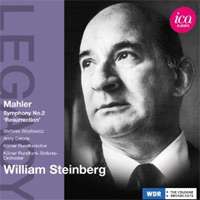|
Back
12/14/2011
Gustav Mahler: Symphony No. 2 in C Minor, "Resurrection"
Stefania Woytowicz (soprano), Anny Delorie (contralto), Kölner Rundfunkchor, Kölner Rundfunk-Sinfonie-Orchester, William Steinberg (conductor)
Recorded at Saar 1, Funkhaus, Köln (September 10, 1965) – 79'38
ICA Classics ICAC 5001 – Booklet in English, French, German

This important issue from ICA Classics fills a gap in the "Mahler renaissance" of the 1960s by offering additional footage of a key player in that revival, German conductor William Steinberg. Steinberg's years as a protégé of Toscanini and, especially, Klemperer come across throughout the performance, which is, for the most part, urgent and high on drama.
The performance features splendid orchestral playing. The brass produce glorious sounds throughout, with pride of place going to the principal trumpet, who plays with utmost musical sensitivity. Woodwinds have the piquant, reedy sound that was a hallmark of German orchestras in the 1960s. Strings produce a rich unison sound and scurry through rapid passagework with exciting precision but are tender and lilting as necessary, pouring on portamenti that would have made Willi Boskovsky proud.
The recorded sound leaves a little to be desired. Dynamic contrast is compressed, and the mystery of many soft passages is simply lost. Loud passages have impressive impact, especially when the organ enters in the finale, but the several juxtapositions of ppp and fff lack the shattering contrast found in studio recordings.
Interpretively, Steinberg pushes the first movement quite hard, clocking in at under 20 minutes, drawing comparison with the justly famous 1962 Klemperer recording. Steinberg seems emotionally removed, yet potent in his convictions. Urgency is key rather than gravity and solemnity. The feeling is electric and breathless, and one is reminded that this music might still have been relatively unfamiliar to these orchestral players.
The second movement suffers most from the lack of dynamic contrast on the recording, although here Steinberg adopts a nice, leisurely pace, with rubato emphasized. The atmosphere created by the main theme of the movement could not be more different than the funeral march that preceded it.
The third movement is disappointing. "Mit Humor" appears several times in the score, yet there is a complete lack of any diabolical fun. Everything is very matter-of-fact, with no pointing up the grotesque dynamic hairpins Mahler painted into the score. Even the opening timpani gesture, allowed to let ring, eschews Mahler's intentions ("every note immediately dampened").
Things turn around in the "Urlicht" and finale. Contralto Anny Delorie is miked extremely closely in her solo movement, but produces a pleasant, mahogany sound throughout. Her voice thins out as it approaches the top of the staff, but this is less a problem here than towards the end of the finale, where she can't match the purity of soprano Stefania Woytowicz's singing. Steinberg continues to push through "Urlicht." The final phrase doesn't return to the opening tempo, and lacks the last bit of nostalgia.
Steinberg's ply up the episodic quality of the first two-thirds of the finale, making it seem like a modernist study in juxtaposition. Only when the chorus enters do we get a true sense of momentum towards the climax. Offstage passagework sounds timbrally distinct but unfortunately not naturally soft. The chorus sings well, but their first entrance is lacking in mystery. Again, this is a result of the dynamic compression, but also the blend and intonation of the chorus aren't as clean as they could be, though this improves in the later a cappella passages. Steinberg seems to get caught up in the excitement of the final build, and the lack of a Luftpause before "Sterben werd' ich, um zu leben!" feels like a hasty error.
As a document, then, this recording is important, but Klemperer's Philharmonia recording is very similar interpretatively and features superior recorded sound and, overall, superior singing and orchestral playing. Likewise, Leonard Bernstein's 1963 recording, while similarly bright in overall sound, features a stunning New York Philharmonic but less-than-ideal vocalists, though in an interpretation that is anything but unsentimental. Steinberg's outing, then, is recommendable to the Mahler completist who wants to further explore the resurrection of these works that was just catching fire in the mid-1960s. For the general collector, however, Klemperer remains untouched.
Marcus Karl Maroney
|